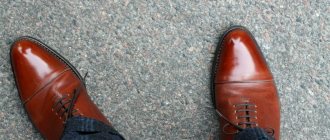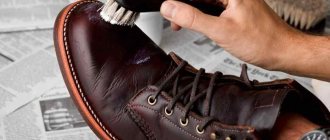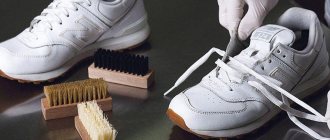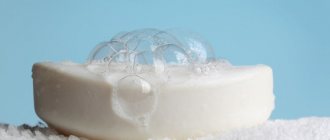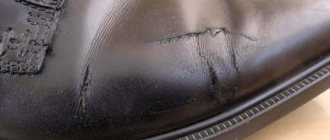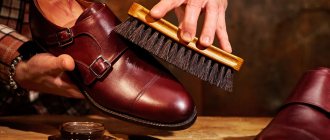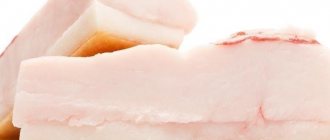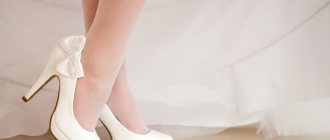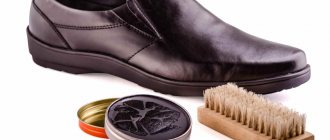Shoes and boots made of oiled/oiled leather can boast of durability and a high degree of practicality, but this does not mean that you can not take care of them. If you want such shoes to last as long as possible, so that they retain their stylish appearance for many years, you need to treat them with due attention. In this article we will talk in detail about how to care for shoes and boots made of oily leather.
Paraboot derby in oiled leather
How to care for light leather shoes - white, beige?
Light-colored shoes in themselves require careful care, and light leather shoes are even more so - they show the slightest cracks, scratches and imperfections.
- Perform a basic treatment with specialized products for fair skin. For white skin, buy special products specifically for white skin; for beige skin, choose products specifically for beige products.
- Do not store light-colored shoes next to black ones - this may negatively affect the color.
- For the same reason, for light-colored shoes it is better to have a separate sponge, which will not have even a drop of black or other dark paint on it.
- To care for light-colored shoes, you need to get a soft sponge for washing and a velvet cloth for polishing.
- On light-colored shoes, due to improper care, yellow spots may appear over time, which can be quite problematic to get rid of. To solve this problem, use mild shampoos that will not wash out the coloring pigment from the skin, unless we are talking about white skin.
Rules of care
You need to take care of your shoes every day. Failure to do this will lead to various problems:
- Spots form on the surface of the skin;
- An unpleasant odor will appear;
- Cracks form;
- Skin color will fade.
What are these rules for shoe care?
After each trip outside, you need to wipe your shoes with a dry or damp cloth, depending on how dirty the shoes are. If the shoes are very dirty, they need to be washed outside using a special shampoo. Start washing from the heel, then wash the sole and only then the outer part.
After washing, shoes should be thoroughly wiped with a soft cloth to prevent moisture from being absorbed deeply into the leather or getting into the seams. If this is not done, the shoes will take a long time to dry, and this can lead to the appearance of an unpleasant odor and mold.
Shoes need to be dried properly. That is, it should dry in natural conditions, away from heating devices. If moisture gets inside, to dry the shoes faster, stuff them tightly with crumpled paper, periodically replacing it with dry paper.
When the shoes are dry, they should be treated with shoe polish so that the leather does not lose its properties and remains soft and attractive. Select the cream according to the color of the shoes. There are universal colorless products.
The cream is applied to the surface of the shoe in a thin layer with a special brush and distributed evenly over the entire surface. It is better to do this in the evening so that the cream has time to be absorbed. Remove any remaining cream in the morning with a soft cloth.
To protect shoes from moisture, they must be treated with a water-repellent spray. It is necessary to soak until the spray stops being absorbed. After this, it is best to place the shoes in a well-ventilated area to dry.
During the rainy season, this should be done once every 5-7 days. In dry weather - once a month. After spraying, the shoes should be rubbed with a sponge or brush. This should be enough for 1 – 3 months. During this period, you can use a soft cloth to remove dust and cream to prevent cracks from appearing. Salt and dirt will no longer be a problem for shoes.
Outsole protection
Most well-known companies - John White, Cheaney, Loake - use vegetable tanned leather to make soles. Of course, this is very convenient, but it wears out quite quickly. Place a rubber outsole - this will protect the sole and make it less slippery, this is especially true for autumn boots.
Rubber outsole
How to clean faucets in the kitchen and bathroom until they shine?
To avoid the hassle of cleaning chrome faucets, just clean them with a paper towel and a little oil. It sounds strange, but it’s worth a try, and the result will exceed all expectations!
There are many alternatives to sunflower oil in the kitchen, which housewives sometimes simply do not know about. To choose the best cooking oil, be sure to read our detailed guide.
Did you like the article? Then support us, click
:
Due to their unique properties, leather shoes are in great demand. But in order for leather products to retain their beauty and durability for as long as possible, they must be looked after regularly.
Proper care of leather shoes includes:
- cleaning immediately upon returning home;
- drying in a dry, ventilated area;
- treatment with skin softening and protective agents.
Folk remedies for the care of shoes made of genuine leather
To care for shoes made of genuine leather, it is better to use special products. But if there is no money to buy them, you can use folk remedies:
- Dilute a few drops of ammonia and a little baby soap in warm water. Using the solution, you can remove dirt and add shine to your shoes.
- Take egg white, 1 tbsp. l. milk and sugar, mix everything and beat until foamy. Lubricate the shoes with the resulting foam and let it soak in. After this, polish with a soft cloth. The skin will become soft and shiny
- If the skin is dry, you can restore it with glycerin and castor oil. The product should be distributed over the entire surface and rubbed in lightly. Repeat the procedure again and then polish the shoes
- If you don’t have anything at hand, you can lubricate your shoes with a rich hand or foot cream
- To protect your shoes from getting wet, you can wipe them with a piece of unsalted lard.
And a few more tips that may be useful in life.
Over time, the brushes you use to apply the cream to your shoes become dirty and rough. It is impossible to wash them with ordinary soapy water. You can clean them with a solution of ammonia.
Pour 2 liters of warm water into a basin and add 2 tablespoons of ammonia. Soak the brushes in this solution and leave for two hours. After this, they can be washed well even with cool water.
If the shoes are wet, but urgently needed, they can be dried with a stream of air from a vacuum cleaner.
You can disinfect boots or shoes and get rid of unpleasant odors using a weak solution of potassium permanganate. Using a sprayer, it must be applied to the surface of the shoe, inside and outside, allowed to dry, and then wiped with hydrogen peroxide.
Stains on leather shoes can be removed with a slice of lemon. To remove a greasy stain, you must first sprinkle it with salt and then wash it off with soap and water.
Before using these products, test them on an inconspicuous area to avoid damaging your skin.
You can prepare an emollient and protective cream at home. To do this, melt 70 g of beeswax in a water bath, add a spoonful of turpentine and castor or olive oil. Mix everything well and pour into a jar with a screw cap. Use as needed.
A few more tips:
After purchasing shoes, read the manufacturer's recommendations for caring for them. If automatic washing is allowed, use it. Some automatic washing machines have a special mode for washing shoes. If your machine does not have such a mode, use the delicate wash mode.
The spin function should be disabled. Set the water heating to no higher than forty degrees. Place your shoes in a special bag, and wash the insoles and laces in a separate bag. If you don’t have a bag, you can use, for example, an old pillowcase.
Do not wash multiple pairs of shoes at the same time, you may damage your washing machine.
Simple recommendations from German Dry Cleaning will allow you to enjoy summer shoes for more than one season!
How to easily grate soft cheese?
Let's start with the kitchen, because this is where sunflower oil is used most often. Remember the classic Druzhba cheese snack? Eating it is a pleasure, but grating cheese is not a task for the faint of heart. Most often, the soft product is simply spread on a grater. To avoid this, just lubricate the tool with sunflower oil (this can be done with a paper towel soaked in oil), and the cheese will slide easily.
Results
In general, as you probably understand, there is nothing complicated in caring for shoes, the main thing is to follow the correct sequence and use high-quality cosmetics, and not black sponges with silicone from some average store. If you wear classic shoes, then you should look towards Kelly's or Saphir cosmetics. If your wardrobe is dominated by boots and just shoes made of durable utilitarian leather, then it is better to purchase Huberd's cosmetics or the shoe brands' own products.
The material was prepared by Alexander Yufa.
What to choose?
There is one main recommendation here - give preference to shoes made from natural materials. Leather and textiles allow the foot to breathe, do not create a greenhouse effect, and the foot in such shoes sweats much less. Artificial materials do not allow air to pass through well, which contributes to the development of diaper rash and fungal diseases on the skin of the feet.
Of course, sometimes you want to wear bright rubber or plastic flip-flops. But don't overuse these shoes. Long-term wearing of shoes with straight soles and without arch supports causes pain in the legs and back.
Shoes made of leatherette are dangerous in any season, since the natural heat exchange in such shoes is disrupted, and in the hot summer, it is better to avoid leatherette altogether. If you do add such shoes to your wardrobe, make sure that the interior trim, which directly touches the skin of your feet, is made of natural textiles or leather.
Patent leather shoes are also not shown in summer. The varnish coating retains moisture and impairs air exchange, so wear patent leather shoes only for special events, and for daily wear, buy sandals, light shoes or sandals made of genuine leather, nabucket, suede or textile. When buying shoes in the summer, remember that your feet swell and become larger in the evening.
Principles of proper shoe storage
An equally important condition for extending the life of leather shoes is proper storage. Off-season or daily storage should be carried out in accordance with the following recommendations:
- You can store leather products on the shelves of a closet, dressing room, in cardboard boxes or wrapped in cotton fabric;
- It is unacceptable to put leather shoes in plastic bags or boxes without access to air - leather does not tolerate this;
- the storage location must be dry and warm so that the covering material does not crack and mold does not appear in the shoes;
- during off-season storage, to maintain their shape, shoes must be stuffed with paper or a wooden spacer must be used;
- Before sending a pair to the shelf, it is necessary to carry out a complete cleaning by covering the shoes or boots with conditioner, cream, protective spray and wax.
The best option for storing shoes is a shoe rack: its advantages are compactness and provision of the necessary conditions for storing leather goods
To store shoes, I have shoe boxes with a transparent window (Ikea), each box contains 2 pairs of children's boots or 1 men's boots, there is a completely transparent box made of plastic, 2 pairs of boots are included there and boots, everything is visible, I want a couple more of these buy the rest of the shoes in boxes, each pair, I sign everything, change the exhibition according to the season, it’s annoying. In Hoffa I looked at shoe racks up to the ceiling, they are flat in the form of a mirror door, but I can’t think of where to put it, and it’s very compact, there’s generally a good selection of all kinds.
Olya
https://www.u-mama.ru/forum/family/housewife/719665/
General rules
On our website we already have a collection of general recommendations that apply to any shoes. You can check out these tips here. We highly recommend following them, because the service life of your shoes and boots directly depends on compliance with these rules. In addition, we advise you to read the article, which explains the intricacies of caring for soles and welts. It tells you how to clean soles, how to protect their ribs, welts and threads on it, as well as how to tint and restore the ribs of soles and heels.
